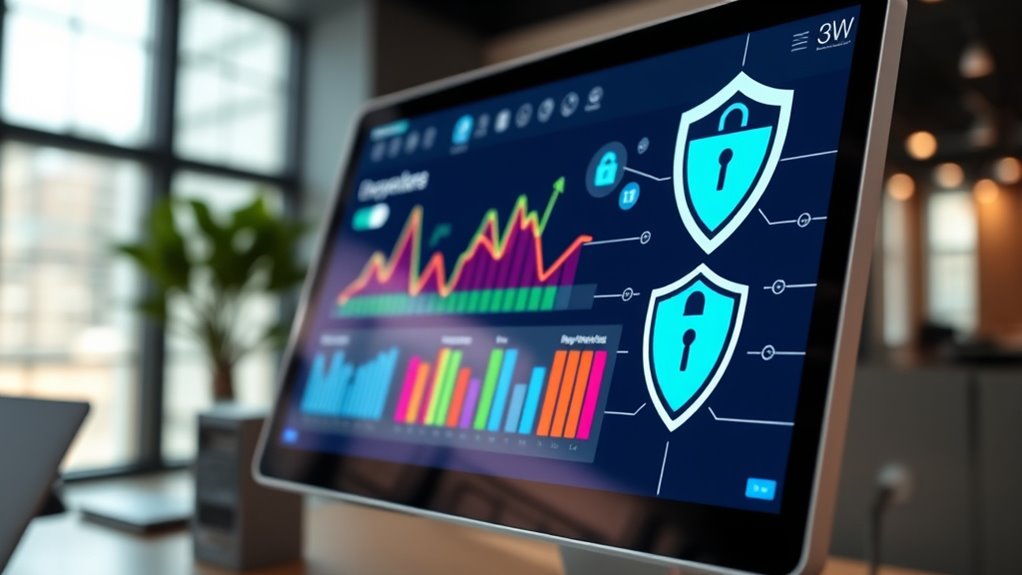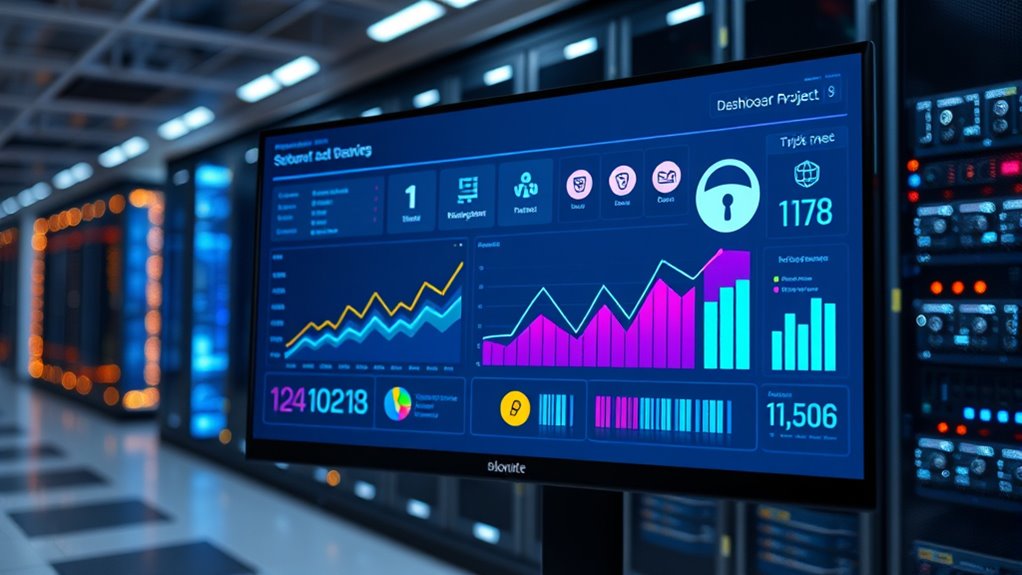Digital PPM platforms protect your sensitive data with strong security features like user access controls that restrict who can view or modify information, and encryption that safeguards data in transit and at rest. They also include multi-factor authentication for verifying identities and activity logs to detect suspicious actions. These measures create a layered defense, ensuring your project details stay secure. Keep exploring to see how these security features work together to protect your organization’s critical information.
Key Takeaways
- Role-based access controls restrict data visibility based on user permissions, preventing unauthorized viewing or modifications.
- Data encryption in transit and at rest safeguards sensitive information from interception and unauthorized access.
- Multi-factor authentication verifies user identities, adding an extra security layer beyond passwords.
- Activity logging and audit trails enable monitoring of data access and help detect suspicious activities early.
- A comprehensive security framework ensures compliance with standards and adapts to evolving cyber threats.

Have you ever wondered how modern project portfolio management (PPM) platforms streamline your workflows and improve decision-making? One of the key ways they do this is by prioritizing security, ensuring that your sensitive data remains protected at all times. When you’re managing multiple projects, user access becomes a critical component. These platforms allow you to control precisely who can see and modify specific data, giving you granular permissions that prevent unauthorized access. You can restrict project details, financial information, and strategic plans to only those team members with the necessary clearance. This not only reduces the risk of accidental leaks but also helps maintain compliance with industry regulations. By implementing role-based access controls, the platform ensures that each user interacts with only the data relevant to their responsibilities, simplifying management and bolstering security.
Modern PPM platforms enhance security with role-based access controls and granular permissions, protecting sensitive data and ensuring compliance.
Alongside user access controls, data encryption plays a crucial role in safeguarding your information. Modern PPM solutions encrypt data both in transit and at rest, meaning your data is protected whether it’s being transmitted over networks or stored on servers. This encryption makes it considerably more difficult for cybercriminals to intercept or access your sensitive data, even if a breach occurs. Encryption algorithms ensure that unauthorized individuals can’t decipher the information, adding an extra layer of security that complements user access controls. Additionally, many platforms incorporate data protection measures, further enhancing your security posture. Together, these features create a robust security framework that keeps your business-critical information safe from malicious threats and internal vulnerabilities.
Many platforms also incorporate multi-factor authentication (MFA), adding an additional layer of security by requiring users to verify their identity through multiple methods—such as a password and a mobile verification code—before gaining access. This reduces the likelihood of unauthorized login attempts, especially from compromised credentials. Additionally, activity logging and audit trails help you track who accessed what and when, making it easier to identify suspicious activity or potential security breaches early on. These features empower you to maintain oversight over your data security and respond swiftly to any anomalies.
Ultimately, the security features of digital PPM platforms aren’t just about protecting data—they’re about giving you peace of mind. You can focus on project execution knowing that your sensitive information is shielded by advanced security measures like user access controls and data encryption. This combination of safeguards ensures your data remains confidential, integral, and compliant with industry standards. As cyber threats evolve, these platforms continue to adapt, integrating cutting-edge security technologies so you can confidently leverage digital PPM solutions without risking your organization’s valuable information.
Frequently Asked Questions
How Do Digital PPM Platforms Handle Compliance With International Data Privacy Laws?
You might wonder how digital PPM platforms stay compliant with international data privacy laws. They handle this by ensuring data residency requirements are met, meaning your data stays within specific geographic regions as mandated. Additionally, they facilitate regulatory reporting, providing detailed logs and documentation to prove compliance. This way, you can confidently manage projects across borders, knowing your platform adheres to global data privacy standards and legal obligations.
What Are the Best Practices for User Access Management in Digital PPM Security?
You should implement clear user roles to define access levels and use strict access controls to protect sensitive data. Regularly review and update permissions, ensuring users only access what they need. Enforce multi-factor authentication and maintain logs of user activity. Educate users on security protocols. By managing user access diligently, you minimize risks and safeguard your platform’s data integrity. Proper user access management is key to overall security.
How Frequently Are Security Updates and Patches Released for These Platforms?
Did you know that 60% of breaches happen due to outdated software? Security update frequency varies by platform, but most providers release patches monthly or quarterly. Effective patch management schedules are essential to stay protected from emerging threats. You should regularly check for updates and apply patches promptly, ensuring your digital PPM platform remains secure. Staying proactive helps prevent vulnerabilities and keeps sensitive data safe from cyberattacks.
Can Digital PPM Platforms Detect and Respond to Security Breaches Automatically?
You might wonder if digital PPM platforms can detect and respond to security breaches automatically. Many platforms incorporate automated breach detection, which identifies threats in real time. They also enable real-time incident response, helping you quickly contain and mitigate risks without manual intervention. This proactive approach enhances your security posture, ensuring that sensitive project data remains protected while minimizing potential damage from cyber threats.
What Encryption Standards Are Commonly Used to Protect Sensitive Project Data?
Did you know that over 80% of organizations use advanced encryption algorithms to safeguard sensitive data? When it comes to protecting project information, common standards include AES (Advanced Encryption Standard) and RSA for data encryption. You can also implement data masking techniques to hide sensitive details during processing or sharing. These encryption standards and data masking methods guarantee your project data stays secure from unauthorized access.
Conclusion
Think of digital PPM platforms as the vaults guarding your most valuable treasures. Their security features act like unbreakable chains, shielding your sensitive data from unseen threats. As you navigate the complex world of project management, remember that these platforms are your fortress, standing strong against breaches. Trust in their protective symbols, knowing your information remains safe inside. With robust security, you can focus on building your empire, confident that your most precious assets are truly secure.









